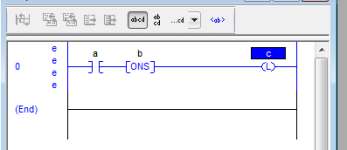einnh
Lifetime Supporting Member
I have some odd 'bugs' in one of our machines here and was wondering the following:

If 'a' is toggled and b allows 'c' to latch. Is there any instance where 'c' would not latch? This seems obvious but my troubleshooting this large program has lead me to this not always occurring for some reason. Is there limitations on how the rung is scanned?
Thanks,
E

If 'a' is toggled and b allows 'c' to latch. Is there any instance where 'c' would not latch? This seems obvious but my troubleshooting this large program has lead me to this not always occurring for some reason. Is there limitations on how the rung is scanned?
Thanks,
E



